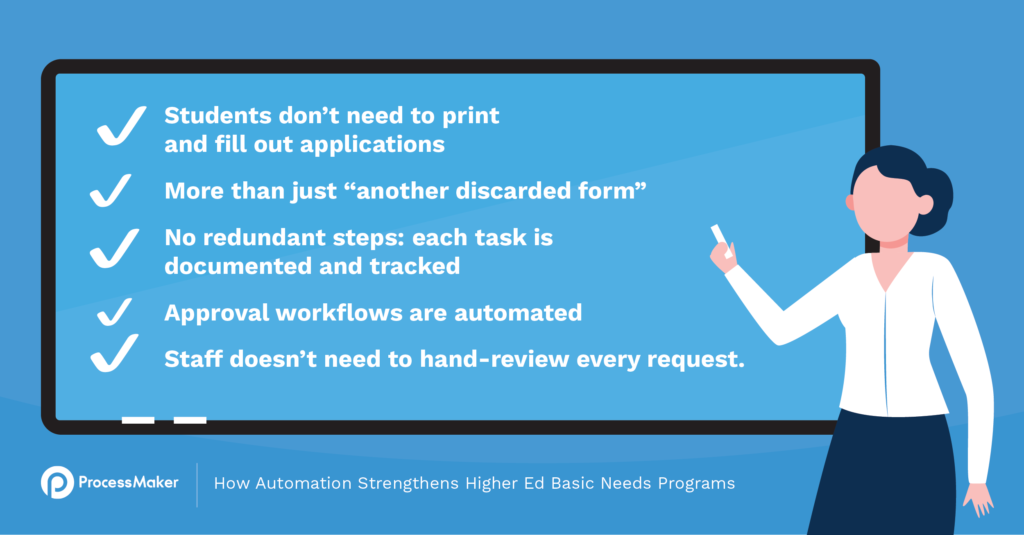Childcare, food security, auto insurance, and housing stability—colleges and universities are now in the business of supporting students with assistance that exceeds traditional financial aid. Some states, like California, are investing millions of dollars into establishing support for basic needs. But to champion these programs, institutions need a lot more than goodwill—they need to have streamlined digital process automation systems in place to succeed.
How does automation help strengthen basic needs support on campus?
Until recently, most on-campus programs revolved around the belief that students were supported by their parents. But a study by New America revealed the average college student is 26.4 years old, while another survey found that half of students visit off-campus food banks.
The changing situation pushes higher ed leaders to rethink their recruitment and retention strategies. Today’s pool of scholars includes new adult learners with families and jobs or returning stop-outs—all who need a new form of student support.
In a presentation by The Michelson 20MM Foundation, basic needs coordinators pointed to four issues colleges and universities must avoid to deliver on this promise effectively. The list included small-scale thinking, short-term thinking, recreating ineffective systems, and unnecessary red tape—four issues digital process automation overcomes fiercely. How?

- Students don’t need to print and fill out applications—everything is available online for instant submission with review and approval workflows that run in the background. Examples: Child Care Services, Housing Assistance, SNAP benefits, etc.
- More than just “another discarded form”: Behind every field on a digital application is an action—one that can perform instant actions like route the request to the right person or store the necessary data in an audit trail.
- No redundant steps: each task is documented and tracked so you can eliminate any hold-ups.
- Approval workflows are automated; meaning forms distribute autonomously to the right personnel who can approve requests without leaving their email inbox.
- Staff doesn’t need to hand-review every request. Where applicable, decisions are made automatically. If a student qualifies for one program, instantly signal other workflows to initiate additional qualifying services. This streamlined process relieves the student of having to prove their need over and over.
The sheer numbers, and faculty, agree. Unmet basic needs are a barrier to college enrollment and student retention.
3 ways top schools are using digital process automation to deliver basic needs initiatives
Automation is helping higher ed teams offer the transformative support students need by helping them:
- Access out-of-classroom experiences that are typically out of reach, like offices hours and field trips
- Reduce stress on those experiencing housing insecurity
- Enroll in more classes, boosting their chances of graduation
- Purchase fresher and healthier foods through programs like CalFresh (an unchallengeable brain boost)
- Find mental health services or other counseling services
- Work fewer hours so they can participate in internships and networking activities that expand career paths
This coveted “whole-student experience” is entirely out of reach without an efficient way to link students to the right services. Here are the three pillars experts suggest for a well-oiled basic needs program and how automation strengthens their success.
Establish a single point of contact
Some schools championing basic needs support still have trouble providing it to those who need it most. In one study, two-thirds of students in need hadn’t even applied for available aid. Why?
Lack of awareness. A student experiencing homelessness may have met with a housing staff member, but did not know about programs like Swipe Out Hunger, where students donate unused meal points. A single point of contact takes the research onus off the student, fully understands their story, and provides them with a bounty of resources in a single meeting.
So institutions appoint an ambassador responsible for stripping back obstacles. This representative has access to all available programs, so students don’t need to coordinate piecemeal needs. They can instantly view what resources are available for the student and help them apply or register in just a few clicks.
Better yet, decisions thread effectively through several departments. Students who get the “ok” from housing need to receive similar attention from related services. Additionally, for many offerings backed by grants or government funding, institutions need to properly track disbursements for audit—a process fully managed by digital process automation.
Distribute assistance quickly
One study found that it took nearly three weeks for higher ed institutions to distribute COVID-related emergency aid. For students experiencing homelessness or food insecurity, 12+ days is an eternity.
Higher ed teams use automation to push requests through at record speeds. No more handwritten forms or PDF print-outs to scan or submit in person. Students fill out a web form—and voilà—back-end magic gets to work.
The form fields students fill out know exactly what to do next. They can share information with other systems, pull information from databases, and ping the right staff member for approval. Processes that used to take weeks can happen in hours or days, making sure much-needed help lands in student hands right when it’s needed.
Connect processes with other departments
For many students, a professor is their sole point of contact. When juggling jobs or families, students in need have little time to negotiate red tape around campus.
That means all staff and faculty, including professors, should be trained on available resources and how to point students in the right direction. With digital workflows in place, professors who notice any red flags can request outreach from a basic needs ambassador. You can link up mental health services, food pantry programs, emergency housing, and transportation teams, so no student need falls through the cracks.
Student basic needs programs are just one of the ways colleges are preparing for the changing face of higher education. See some of the other processes colleges and universities are automating to turn lengthy forms and requests into click-of-a-button successes.





